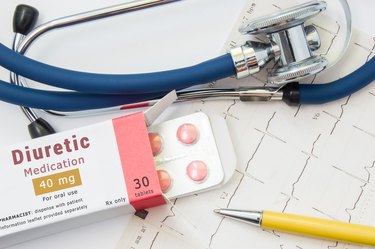
Diuretics are a commonly prescribed medication, but they come with a perplexing puzzle for you. They are water pills that are supposed to help get rid of excess fluid, but they make you thirstier. It seems counterintuitive to drink more when you are on a pill to get rid of water, but that is what your body wants to do.
You doctor should give you specific instructions about how much fluid you should drink for your medical condition. If you have heart and kidney problems, you may need watch your fluid and count every drop.
Video of the Day
Video of the Day
Diuretics Explained
Diuretics are medications designed to move water out of the body. If you have too much fluid backing up in your feet or in your lungs, these medications will signal your kidneys to produce more urine to get the fluid moving out. They also affect the electrolytes, or nutrients, in your body to help move the fluid out of the tissues.
According to MayoClinic.com, there are three different types of diuretics: loop diuretics, thiazide diuretics and potassium sparing diuretics. Each type moves fluid in a different way and has different side effects.
Reasons to Take Diuretics
Your doctor may put you on a diuretic for a number of reasons, but there are a few common ones. Diuretics can help to lower your blood pressure. According to MayoClinic.com, thiazide diuretics should be the first-line medication to treat high blood pressure.
Another common use for these medications is congestive heart failure. This is when your heart is unable to beat effectively and fluid backs up. Limiting fluids, taking diuretics and paying close attention to your weight are all ways to manage this condition.
Fluid and Diuretics
The specific amount of fluid to take while on a diuretic is complicated and something for your doctor to determine. The amount of fluid you need per day can depend on your weight and calorie intake.
Your doctor may want you to restrict your fluid if you are a congestive heart failure patient, so your fluid allowance may be less. However, you must still drink to prevent dehydration from the diuretic. Maintaining your fluid status is very important when taking a diuretic. It is essential that you and your doctor are clear on this point.
Coping with Fluids Restrictions
Fluids and diuretics are challenging, but there are things you can do to deal with your restrictions. Try drinking from smaller glasses, and only allow yourself to have a measured amount of fluid per hour.
Remember that items such as gelatin, ice cream and pudding count as fluid, so try to limit those foods. Chew gum or buy some mouth-moistening products to help with dry mouth. Instead of plain water, try water with lemon or lemon ice to quench your thirst. Above all, keep a log of your water intake and stick to your allowance.
Side Effects of Diuretics
Some side effect of diuretics result from low electrolyte levels and some are from low fluid levels. According to MedlinePlus, fatigue, muscle cramps and weakness can result from a lack of potassium. These are side effects of the loop diuretics, such as furosemide.
Other side effects can include dizziness, numbness, palpitations, depression, gout and being unable to hold your urine. Taking your diuretic in the morning, and when you know you will be close to a restroom, can help with the frequent urination.
Is this an emergency? If you are experiencing serious medical symptoms, please see the National Library of Medicine’s list of signs you need emergency medical attention or call 911.